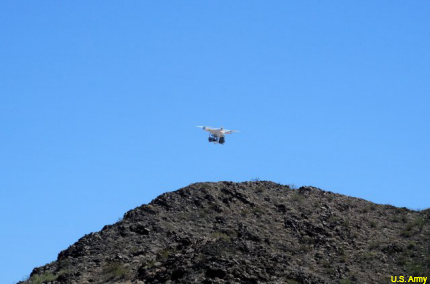Army testing defenses against small, commercial UAS
During demonstrations this summer, the Army tested various counter-unmanned aerial systems platforms to address the growing threat posed by small drones.

Commercially available UAS such as the Phantom 3 pose a potential threat.
flying IEDs
The Rapid Equipping Force and the Asymmetric Warfare Group are teaming for solutions to defend soldiers and assets from these threats. "The enemy is using these small systems," Lt. Col. Stephen Lee, AWG Concepts Integration Squadron commander, said in an Army release. “We don't want the United States Army ever to be caught by surprise again like we were with the IED.”
Separatists in Ukraine backed by Russia are using small UAS for intelligence, surveillance and reconnaissance, but it is not far off for these small platforms to be outfitted with explosives and sent on one-way missions, given their expendability.
REF, which looks at new technology and material solutions, and AWG, which focuses on non-material solutions such as tactics, techniques and procedures, conducted tests at AWG’s training facility in Virginia replicating the threat, launching multiple types of UAS.
In September, a live-fire exercise was conducted in Arizona, testing technologies that could bring down potentially threatening drones. During the tests, AWG posed as the red team, or opposing force. "We took a lot of these off-the-shelf hobby-shop, low-slow types of devices [and] went against an adversary," said Col. Steven Sliwa, director of REF, said.
Silwa said that the results from the tests should be published later this month, and noted that several other technologies were featured and several agencies participated in the tests with REF examining the most viable and successful options to be deployed.
According to a non-Army spokesperson with the Rapid Equipping Force, the Army is not disclosing the systems that participated in the recent tests. The spokesperson did tell Defense Systems in an email that both government and commercial systems were tested and featured kinetic, radio-frequency, radar and optical methods.
Back in April, the Army conducted a live-fire test for a counter-UAS platform modified from a system previously designed to counter rockets, artillery and mortars. The system can include a 50mm cannon to launch command-guided interceptors and use a precision-tracking radar interferometer as a sensor, a fire-control computer and a radio-frequency transmitter and receiver for launching munitions into an engagement basket. In fact, the same platform tested in April was used during the live-fire exercise in Arizona in September.
The Army is working with the private sector and other government agencies for suitable systems. “Our technology outreach team has been briefed on numerous systems, but if a company has a system it thinks is ready to be inserted with a unit they should reach out to the REF through our website: www.ref.army.mil,” the spokesperson said.
Other Army offices contributing to this effort include the Training and Doctrine Command, the Research, Development and Engineering Command as well as the Joint IED Organization with REF opening a lab in Kuwait.
NEXT STORY: US approves sale of Global Hawks to Japan